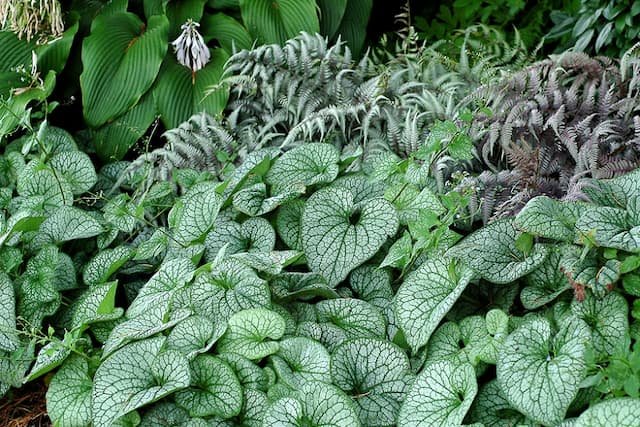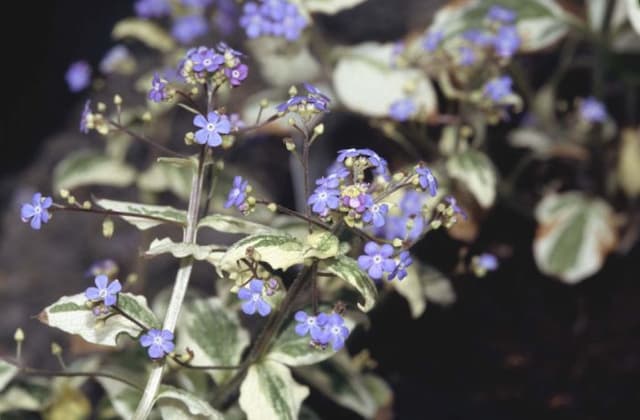Forget-me-not Myosotis My Oh My = 'Myomark' (PBR)

ABOUT
The Myosotis My Oh My, commonly known as forget-me-not, is a delightful flowering plant that captivates with its charming appearance. The plant has a lush green background formed by its foliage, comprising small, ovate to lance-shaped leaves with a smooth to slightly hairy texture. The leaves create a dense and neat backdrop for the star attraction, which is the abundance of tiny, delicate flowers. These blooms are typically a soft blue hue, though they can sometimes appear in shades of pink or white, each with a contrasting yellow or white center that adds a twinkling effect. The flowers are composed of five rounded petals that radiate around the central eye, resembling a classic wildflower shape that embodies a quaint and romantic aesthetic. The blooms are often clustered together, forming small bouquets on branching stems that weave through the green leaves, creating a tapestry of color that is both soothing and picturesque.
About this plant
 Names
NamesFamily
Boraginaceae
Synonyms
My Oh My Forget-Me-Not, Myomark Forget-Me-Not
Common names
Myosotis My Oh My.
 Toxicity
ToxicityTo humans
The common name for Myosotis 'Myomark' is Forget-Me-Not. Generally, Forget-Me-Nots are not considered toxic to humans. They do not contain significant quantities of toxic compounds, and there are no well-documented cases of poisoning from the ingestion of Forget-Me-Nots. Therefore, accidental ingestion of parts of this plant would not typically result in symptoms of poisoning or severe consequences to humans. However, it's always prudent to avoid eating plants not classified as food due to potential allergic reactions or individual sensitivities.
To pets
The common name for Myosotis 'Myomark' is Forget-Me-Not. These plants are not known to be toxic to pets, including dogs and cats. They are generally considered safe, and ingestion is unlikely to cause more than mild gastrointestinal upset, if anything at all. No specific symptoms of poisoning are expected from the ingestion of Forget-Me-Nots. It is always wise, however, to monitor pets for any unusual behavior or symptoms after ingesting any plant material, as individual reactions can vary.
 Characteristics
CharacteristicsLife cycle
Biennials
Foliage type
Deciduous
Color of leaves
Green
Flower color
Blue
Height
0.5 feet (15 cm)
Spread
0.5 feet (15 cm)
Plant type
Herb
Hardiness zones
5
Native area
Europe
Benefits
 General Benefits
General Benefits- Attractive Flowers: Myosotis, commonly known as Forget-Me-Not, features charming flowers that add aesthetic appeal to gardens.
- Long Blooming Period: The 'My Oh My' variety typically offers an extended blooming season, providing color for longer periods.
- Easy to Grow: Forget-Me-Nots are recognized for being easy to cultivate, requiring minimal maintenance.
- Drought Tolerance: Once established, they can show moderate tolerance to drought, making them suitable for various climates.
- Pollinator Friendly: The flowers attract bees, butterflies, and other beneficial pollinators, which are essential for the health of the ecosystem.
- Edging Plant: With its compact growth habit, Forget-Me-Not is an ideal choice for borders and edges in garden design.
- Shade Tolerance: Capable of growing in shady areas where many other flowers might struggle.
- Combination Planting: Works well when planted in combination with other perennials, providing textural contrast and layers in garden beds.
- Self-Seeding: Often capable of self-seeding, which can lead to new plants popping up in subsequent seasons without additional effort.
- Versatile Use: Suitable for use in containers, hanging baskets, and as ground cover, offering versatile gardening options.
 Medical Properties
Medical PropertiesThis plant is not used for medical purposes.
 Air-purifying Qualities
Air-purifying QualitiesThis plant is not specifically known for air purifying qualities.
 Other Uses
Other Uses- Edible Decorations: The flowers of the Forget-me-not can be crystallized and used as edible embellishments on cakes and desserts, adding a delicate floral touch.
- Natural Dye: The blossoms can be used to produce a natural blue or green dye for coloring textiles, papers, or Easter eggs.
- Photography Prop: The vibrant blue flowers can serve as an excellent photography backdrop or prop, enhancing the visual appeal of pictures.
- Memory Aids: Due to its associative name, Forget-me-nots can be planted in memory gardens or given as gifts to serve as a living reminder of a special person or event.
- Garden Companions: These plants help indicate soil moisture levels in gardens, as they prefer consistently moist soil, thus informing gardeners when to water.
- Art and Crafts: The flowers may be pressed and used in crafting, such as in the creation of bookmarks, greeting cards, or in scrapbooking projects.
- Educational Tool: Forget-me-nots can be used in educational settings, such as schools or botanical workshops, to teach children about plant biology and the lifecycle of flowers.
- Horticultural Therapy: Growing Forget-me-nots can be part of therapeutic garden programs aimed at improving mental and physical health through active interaction with plants.
- Memory Projects: Crafting a pressed flower memory book that includes Forget-me-nots can become an intergenerational project to foster storytelling and reminisce.
- Tattoo Inspiration: The distinct appearance and symbolism of the Forget-me-not flower make it a popular choice for botanical tattoo designs.
Interesting Facts
 Feng Shui
Feng ShuiThe Myosotis, commonly known as Forget-Me-Not, is not typically mentioned in Feng Shui practice.
 Zodiac Sign Compitability
Zodiac Sign CompitabilityThe Forget-Me-Not is not used in astrology practice.
 Plant Symbolism
Plant Symbolism- True Love: The most well-known meaning of the Forget-Me-Not, which is the common name for Myosotis 'Myomark', is true and undying love. The flower is often used as a symbol of deep romantic affection and the promise to remember someone forever.
- Remembrance: Forget-Me-Nots embody the concept of remembrance. They are often used in the context of remembering someone who is absent, or in memory of those who have passed away, serving as a token of memory that lasts through time.
- Faithful Love: Beyond true love, this plant suggests a faithful, steadfast kind of love. It's the kind of romance that endures trials and persists despite separation or difficulties.
- Friendship: Not only confined to romantic gestures, the Forget-Me-Not is also emblematic of steadfast and supportive friendship, indicating a bond that is cherished and remembered.
- Hope: The Forget-Me-Not flower is also a symbol of hope, particularly in difficult or challenging circumstances. It's a reminder that there is something to look forward to and hold onto for the future.
 Water
WaterFor the Forget-me-not, known commonly as Myosotis, water whenever the top inch of soil feels dry to the touch, typically around once a week. During the growing season, the plant may require more frequent watering, approximately two times a week, depending on the environmental conditions. Ensure you provide enough water to moisten the soil thoroughly, using around a half to one gallon each time, depending on the size of the plant and the pot. Overwatering can lead to root rot, so ensure proper drainage is in place.
 Light
LightMyosotis, commonly known as Forget-me-nots, thrive best in partial shade to full sun. They benefit from bright, indirect light but should be protected from intense, direct sunlight during the hottest parts of the day. A spot that receives morning sunlight and is shaded during the afternoon heat is ideal for these delicate blooms.
 Temperature
TemperatureForget-me-nots prefer a cool to moderate range of temperatures, with ideal conditions between 60°F and 70°F. They can typically endure short periods of colder weather down to about 40°F but should be protected from frosts. High temperatures over 80°F may cause the plant to go dormant or struggle, so it's essential to provide some shade during the hottest parts of the summer.
 Pruning
PruningPruning Forget-me-nots is beneficial to promote bushier growth and prolong the flowering period. Deadhead spent flowers regularly to encourage new blooms. After the main flowering season, cut back the stems by half to revitalize the plant. The best time for a more thorough pruning is late winter or early spring before new growth begins.
 Cleaning
CleaningAs needed
 Soil
SoilForget-me-nots, including the Myosotis 'Myomark', thrive in well-draining, moist soil rich in organic matter. The best soil mix would be a combination of garden soil, peat, and perlite or sand to improve drainage. They prefer a slightly acidic to neutral pH of 6.0-7.0.
 Repotting
RepottingForget-me-nots like 'Myomark' typically do not require frequent repotting and it is often not necessary unless the plant has outgrown its current container. However, if grown in pots, they should be repotted every 1-2 years to refresh the soil.
 Humidity & Misting
Humidity & MistingForget-me-nots, including 'Myomark', prefer moderate to high humidity levels but are adaptable to average household humidity. Aim for a humidity level between 40-60% for optimal health.
 Suitable locations
Suitable locationsIndoor
Place in bright, indirect light and keep soil evenly moist.
Outdoor
Choose partial shade; keep the soil moist and well-drained.
Hardiness zone
4-9 USDA
 Life cycle
Life cycleCommonly known as the Forget-me-not, 'Myomark' begins its life cycle as a seed which, when sown and given appropriate moisture and temperature, will germinate and produce small seedlings. These seedlings grow into juvenile plants with characteristic foliage, and as they mature, they develop a compact bushy habit with dense, leafy growth. When environmental conditions are favorable, typically in spring, the plant enters its flowering phase, producing small, delicate blue flowers with a yellow center that are characteristic of Forget-me-nots. After pollination, which is often facilitated by insects, the plant will produce tiny fruit containing seeds. As the flowering season concludes, the plant eventually senesces, with above-ground parts dying back, while seeds fall to the ground to initiate the next generation. In many cases, the plant may exhibit a perennial life cycle, re-emerging from its root system for several growing seasons before completing its lifecycle.
 Propogation
PropogationPropogation time
Spring-Early Summer
The Myosotis My Oh My, commonly known as Forget-me-not, is frequently propagated by seed. The best time for sowing seeds is in spring or in fall. To propagate by seed, scatter the tiny seeds either directly into the garden or into a tray with well-draining seed starting mix. Barely cover the seeds with soil, as they require light to germinate. Keep the soil moist but not waterlogged, and at a temperature of about 70°F (21°C). Seedlings will emerge in 8-14 days. Once they're large enough to handle, transplant them into their final growing position, ensuring they are spaced adequately to allow for mature growth.









